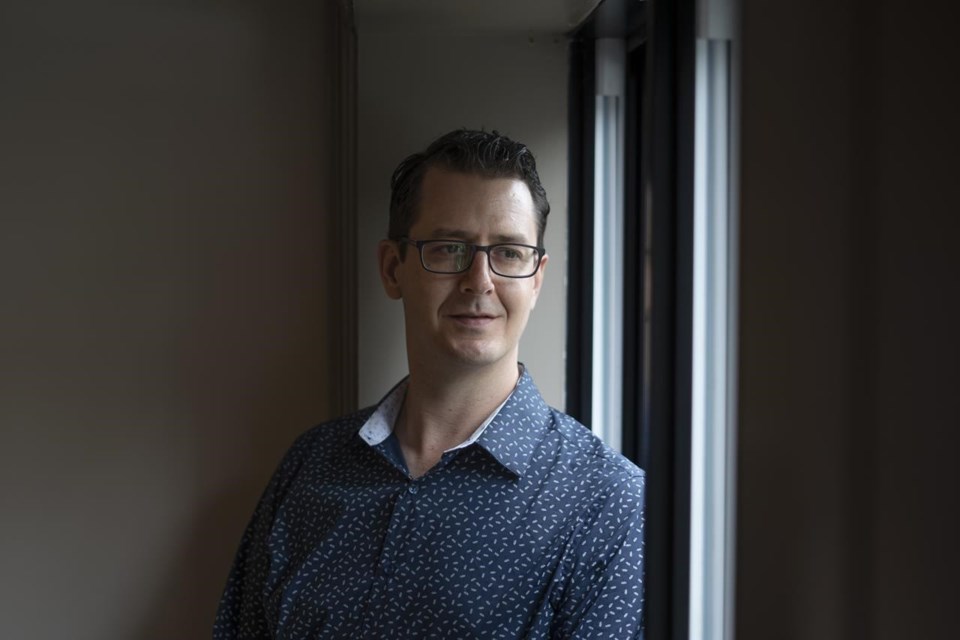HALIFAX ŌĆö The man in his 60s looks down for a moment at his dining room table, and then tries to explain how a shameful moment of violence was also the beginning of a healing journey.
About two years ago at his Halifax-area home, the man says, his wife stood in front of his truck, trying to stop him from driving after he had been drinking.
He struck her leg with his truck as he drove around her over the lawn, resulting in charges of assault. His lawyer helped him enter a domestic violence program for men, which led to admission to a program for men who, like him, had been sexually abused. Both programs were provided by the non-profit Peoples' Counselling Clinic in Halifax.
ŌĆ£God, IŌĆÖd trade anything in the world for this incident to not have happened, but I still probably wouldnŌĆÖt have had help without this happening," said the man, whom The Canadian Press granted anonymity because many of his friends and family are unaware of his criminal case and the sexual abuse he suffered as a teen.
ŌĆ£I donŌĆÖt know where IŌĆÖd be without the clinic's programs," he said in an interview. "IŌĆÖd probably be dead."
Gender violence experts say such personal change by men ŌĆö balanced with victim protection ŌĆö is key to addressing partner abuse in Canada, highlighted as "an epidemic" in the final report of the recent inquiry into the 2020 Nova Scotia mass shooting. Twenty-two people were killed by a man who had previously abused his spouse and other women.
The man charged with assaulting his wife says that for more than 40 years he hadn't spoken about his own abuse by a Roman Catholic priest when he was a 13-year-old altar boy. He medicated the trauma with alcohol, while putting in 16-hour days as a senior project manager.
"I brought this on myself," he said. But he adds, "If I'd had somewhere to go in the past, I could have talked it out."
He's now back at home, his 41-year marriage is intact, and he is abstaining from alcohol.
James Dub├®, clinic manager of the Peoples' Counselling Clinic, said it's not uncommon for men in the domestic violence program to also be referred to the clinic's "ManTalk" treatment for men who have suffered sexual abuse.
"Many times people have been refused services and they're trying desperately to get help and don't," he said.
But could such extreme cases as Nova Scotia mass shooter Gabriel Wortman, who an inquiry found had been emotionally abused as a child, be helped by such programs?
"Gabriel Wortman was an anomaly. But we're seeing the rise of more anomalies ŌĆ” they're out there," said Dawn Ferris, director of the Cumberland County Transition House Association, based in Amherst, N.S.
"We have to start somewhere, and we have to start looking at it ŌĆ” without judgment, to actually fix the problem in the hopes that it reduces the chances of a future Wortman."┬Ā
She said that while there are five centres in the province offering in-person men's programs, they often occur on a 9 a.m.-to-5 p.m. schedule, and they aren't available in some regions. Ferris argues that programs to deal with abusers should evolve to the point where a man can access them at any time of day or night for immediate support.
The commission of inquiry heard testimony last year from Katreena Scott, a clinical psychologist at Western University, who said her review of research indicates that abusive men can be helped with treatment. "Between one-third and two-thirds of men who have perpetrated at least one instance of abuse go on to avoid subsequent abusive behaviour," she said.
In light of this and similar testimony, the commission recommended that governments "prioritize prevention ŌĆ” including interventions with perpetrators."
Nancy MacDonald, director of the non-profit Family Service of Eastern Nova Scotia, based in Antigonish, said her group's 24-hour helpline for men, created during the pandemic, has seen a "huge uptake."┬Ā
She estimated social workers on staff are now receiving up to 600 calls monthly, most of them after regular business hours, and some of them from men at risk of committing domestic violence.
"What the men's helpline has shown is that if the services are there, then people will access the care," she said.
However, Rick Goodwin, director of the Men and Healing psychotherapy clinic in Ottawa, said research suggests programs are most effective when they are linked to treatment for prior sexual, physical and emotional abuse.
He said that in Ontario the majority of male violence prevention programs are based on a model from Minnesota that focuses on holding abusers accountable and teaching how male dominance in society often leads to men believing they should control and dominate women.
While this may be an underlying explanation for a social ill, the approach isn't proving to be effective in altering behaviour, he said. "You have to go back and find some way to address the (men's) wounds," Goodwin said.┬Ā
Two years after his violent incident, the Halifax-area man who hit his wife's leg with a truck said he is still participating in group therapy programs via Zoom. But he is also helping others. He said he is the oldest participant in the therapy programs, and at times he offers advice to younger men struggling to end their own violent behaviours.
"Some of the younger guys, I would tell them, ŌĆśThereŌĆÖs a way to approach this that would be better,'ŌĆØ he said.
This report by The Canadian Press was first published July 3, 2023.
Michael Tutton, The Canadian Press



